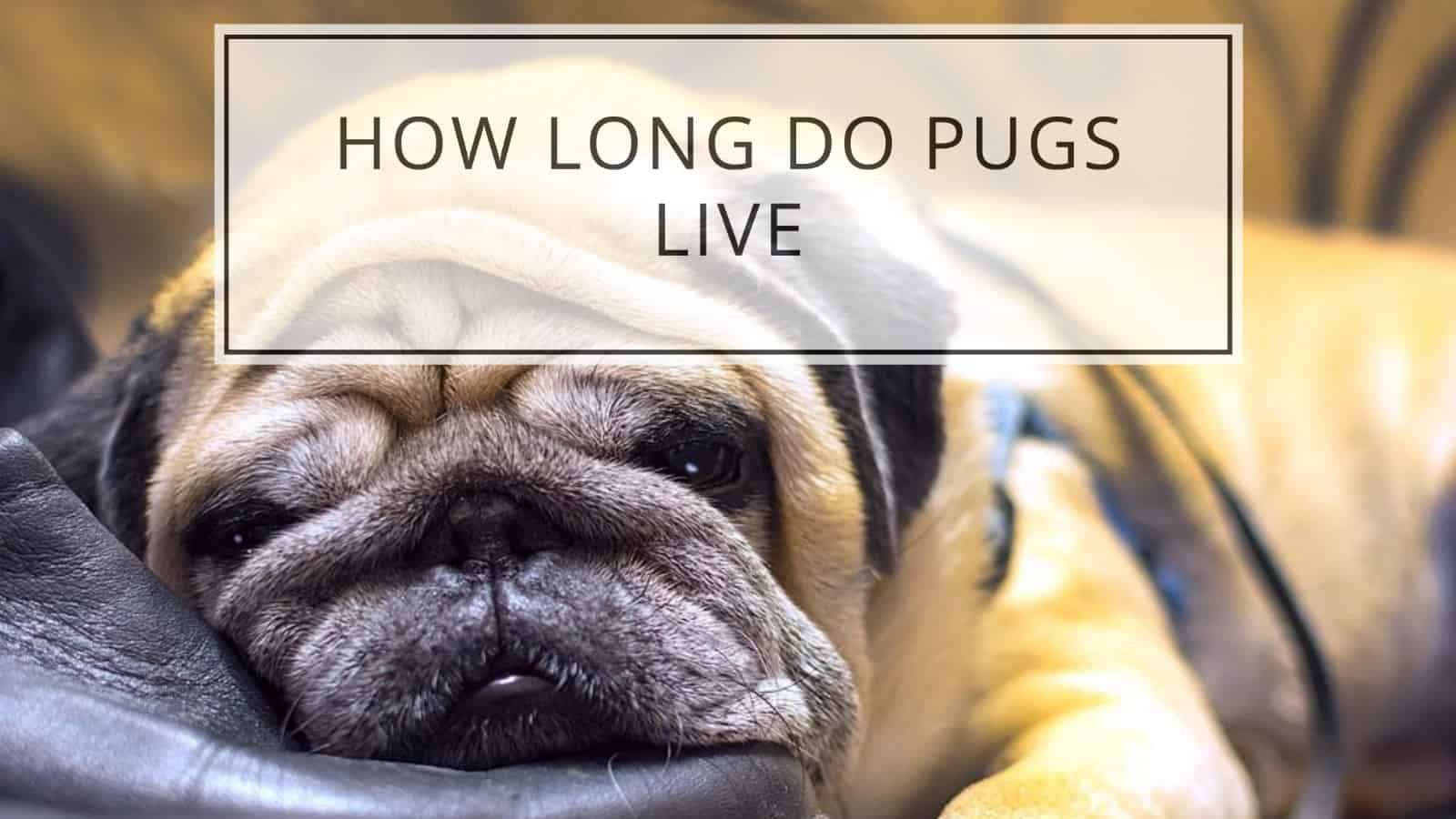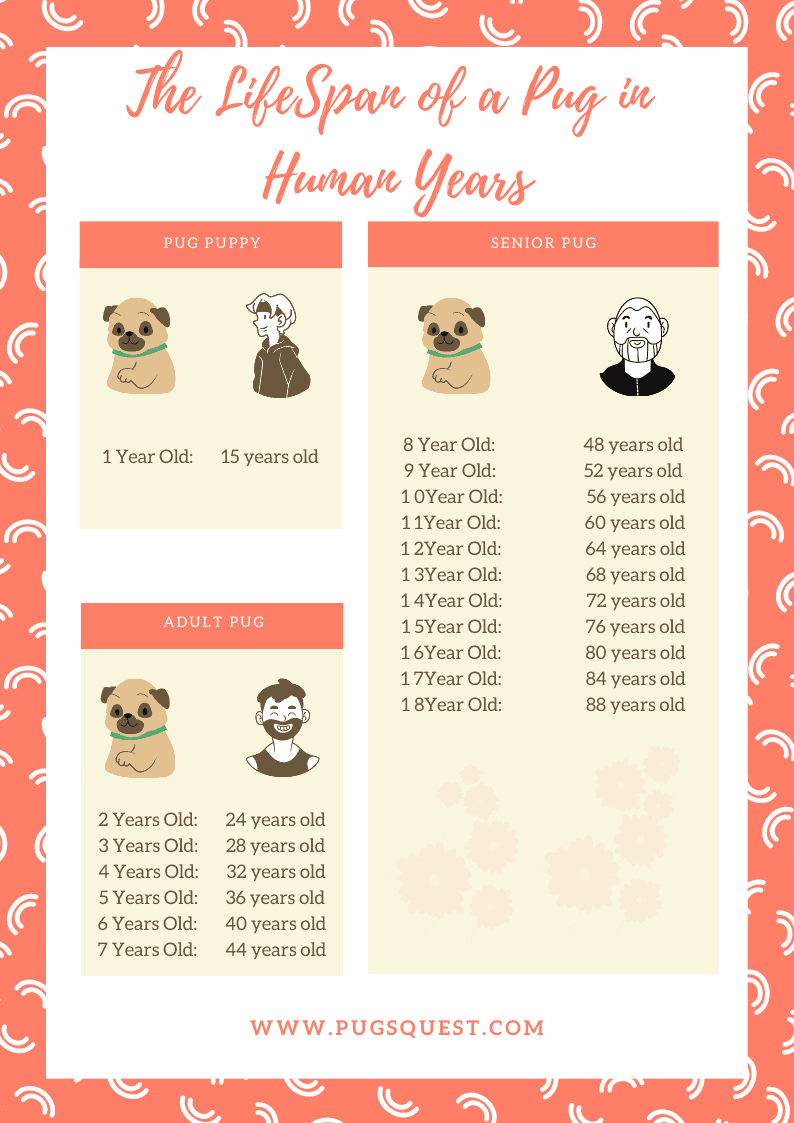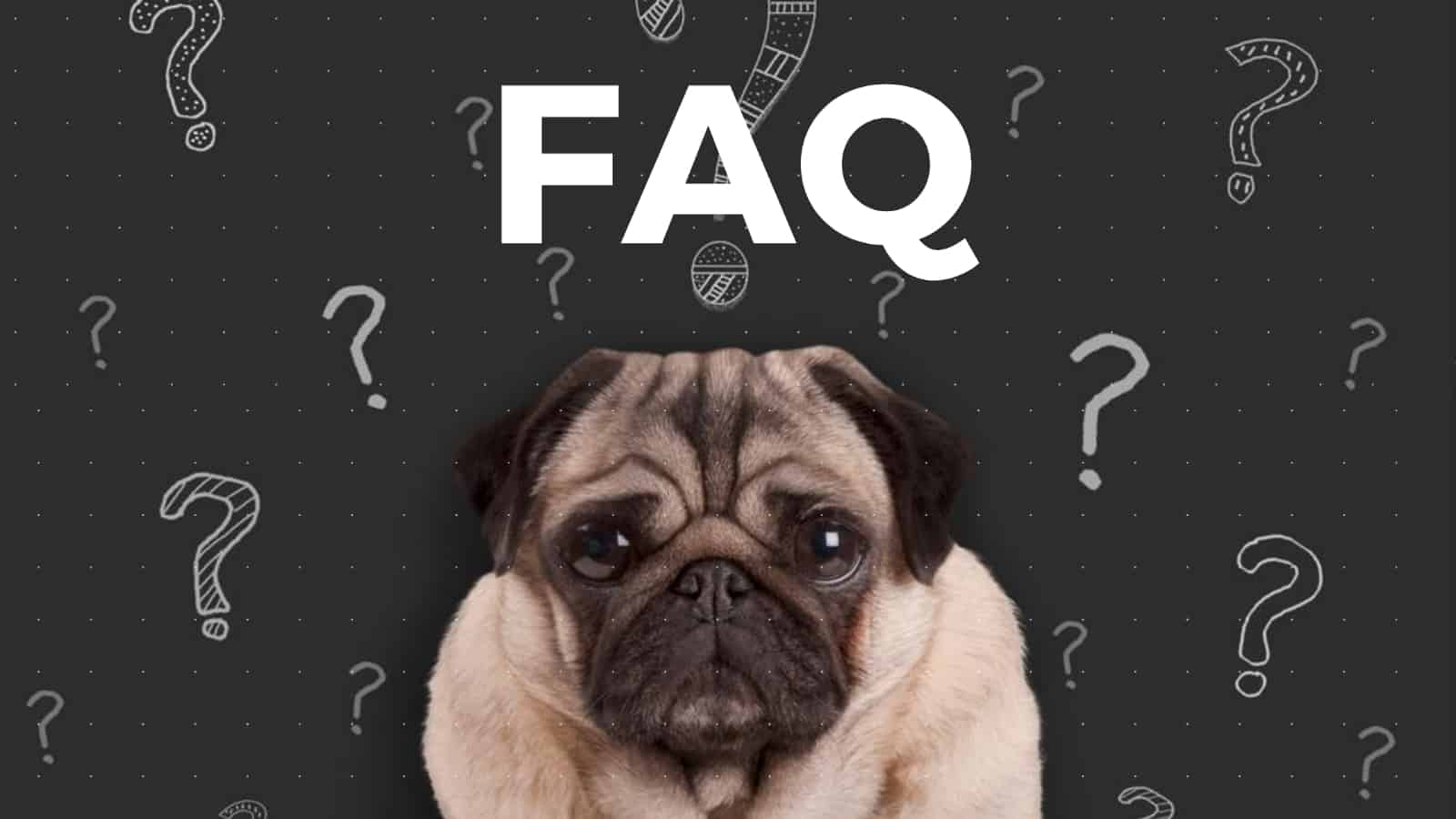If you’re looking for a charming, amusing, loving, and social dog breed, your best option is a pug.
Sadly, pugs need tender care, as they are prone to rare diseases, mainly because of their looks.
In this article, you’ll learn:
- How long pugs live and their life span
- What you can do to prolong their lives
- What they die from
- How to make the last memorable moments
Let’s dive in!
How Long do Pugs Live?
A recent study showed that pugs live for approximately 12-15 years.
The average life expectancy for female pugs is 13.2, while males have a shorter life span of 12.8 years.
Now the good news is, with good living conditions, a pug can live more than15 years.
For example, King Tug the Pug, the oldest Pug in America, is 18 years old.
1. My Pug is Obese. Will He Still Live for 12-15 Years?
Pugs can be lazy, and they also tend to overeat. They also love to sleep and hate to stroll, which results in obesity in the long run.
Overweight pugs struggle with cardiac problems, breathing difficulties, and other ailments.
This means your pug may not live up to the average 15 years that healthy pugs live.
2. Life expectancy for a pug with Pug Dog Encephalitis (PDE)
If your dogs have just been diagnosed with PDE, this can be very devastating.
The scariest part of this disease is that no one knows what causes it, and there is no cure for it yet.
Pugs are more vulnerable to PDE when they’re 2 or 3 years of age.
Female pugs are more prone to the disease than their male counterparts.
Although they’re ways to ease PDE symptoms, there is no cure so pugs with the ailments hardly live for 10 years.
3. Life expectancy for pugs with diabetes
If your pug is diabetic, you don’t have to worry. You only need to treat and properly control it, and they can live a healthy lifestyle.
The cherry on top is that a diabetic pug has a chance to live the same lifespan as a healthy pug.
Nevertheless, a pug’s life may be cut short if the diabetes isn’t controlled, as it may lead to other illnesses.
The LifeSpan of a Pug in Human Years
This may seem far-fetched, but understanding your dog’s age can help you know when to treat them like seniors.
According to American Veterinary Medical Association, the first year pug is equal to a 15 years old human. Let’s break down more details:
What do Pugs Usually Die From?
Some of the leading causes of pug’s death are:
- Congenital Disease
These are ailments that are present in a pug’s life at birth.
They include stenosis (abnormal narrowing of spaces within the spine), heart defect, or septal defect (improper blood flow).
- Cancer
The most common cancers that strike pugs include mammary tumors, skin tumors, mouth cancers, testicular tumors, and lymphoma.
Although when cancer is discovered promptly, it’s treatable, it can cause death if it has progressed too far to cure or diagnosed late.
- Neurological disorders
This is among the leading causes of pug deaths. These are ailments that affect a pug’s nervous system.
The latter includes spinal cords, nerves, and the brain. The most common fatal neurological disorders among pugs is the PDE.
The latter causes brain inflammation, which causes lethargy, loss of muscle control, and seizures.
- Infections
Some skin infections and yeast infections are serious, but they’re not death threatening.
However, infections such as bacterial infection, viral disease, protozoal disease, and fungal infections can cause death.
- Diet
Do you know the old saying that you’re what you eat? It applies to dogs too.
A poor diet full of sugar, fat, and empty calories can affect a pug’s lifespan.
What Changes do Pugs Experience as They Get Older?
A pug is identified as a senior between 7-9 years. The vet determines the timing.
Some pug owners start their pug’s transition from adulthood to senior too late because they miss all the signs.
Here are signs that your pug is getting old and needs senior care:
- Hearing loss
This can be especially hard because dogs have excellent hearing skills.
Before this happens, start teaching your pug hand signals to help them understand what you’re requesting.
- Muscle/fat ratio
Like human beings, as dogs age, they lose muscle loss, and their bodies store more fat.
- Physically slowing down
The body structure of a pug puts a lot of stress on its knees and legs as it grows old; in most cases, it can lead to arthritis.
Tricks to Prolong a Pug’s Life Span
Eventually, you’ll have to bid your pug goodbye, but it doesn’t have to be soon.
With proper care, you can increase the number of years your pug lives.
Here are the secrets of increasing a pug’s life span:
1. Check Your Pug’s Weight
We can’t stress this enough. An obese pug will eventually develop other health problems that could lead to other secondary diseases.
So, how do you make sure your pug’s weight is on track? For starters, feed your puppy with high-quality food and healthy treats.
You’ll have to be disciplined as pugs are great manipulators, and they can easily coax you to give in to their demands.
Just practice some tough love, and your pug will enjoy a healthy, long, and happy life.
But how much weight is too much for my pug? See the table below:
| A Pug’s Age | Healthy Weight(Lbs) |
| 8 Weeks | 4lbs |
| 9 Weeks | 4.5lbs |
| 10 Weeks | 5lbs |
| 11 Weeks | 5.5lbs |
| 12 Weeks | 6lbs |
| 13 Weeks | 6.5lbs |
| 14 Weeks | 7 lbs |
| 15 Weeks | 7.5 lbs |
2. Be Cautious With This Brachycephalic Breed
The pug’s structure (stout, heavy body, and short muzzle) makes swimming very difficult for them.
For this reason, you must supervise your pug if you allow them near a water body and get them a life jacket.
Also, prevent them from overexerting themselves or getting too excited as this could lead to breathing distress.
Don’t cut on the exercise completely; just take it easy on them and watch out for any exhaustion or breathing troubles.
3. Dental Care
Just like you, pugs need regular dental cleanings. If the dental visits are costly, make sure you take care of their teeth by brushing their teeth.
As your pug gets to their senior age, they can lose their teeth if they weren’t taken care of at their younger age.
In this case, you may have to switch their diet from dry food to soft food that they can digest.
4. Joints
Like human beings, pugs are susceptible to diabetes, arthritis, and other illnesses that can affect their life expectancy.
Carrying too much weight can cause your pug’s bones to become fragile.
Their short legs aren’t meant to carry excess weight like normal dogs.
5. Senior Food
As your pug gets older, you’ll need to switch to senior dog food. Food for aging seniors is packed with proper nutrients.
You’ll also need to make sure your pug’s diet doesn’t cause quick weight gain.
Also, consider asking your vet for supplement recommendations. Here are some tips:
- Get high-quality food or opt for home-cooked food
- Avoid feeding your pug with unhealthy snacks and fatty foods, and replace them with wholesome foods such as raw baby carrots.
- Take time to schedule your pug’s meal to avoid spur moments that may tempt you to feed them with snacks.
- Besides a healthy diet, give your pug healthy supplements (ask your vet for the best supplements depending on your pug’s age).
6. Eye Care
Pugs are prone to glaucoma because of their bulging eyes.
If your pug loses their eyesight (mostly happens at their senior age), make sure you retain all the furniture positions.
And your pug will still move without any difficulties.
7. Bladder Control
As your pug continues to grow, their bowel muscles become weaker.
Therefore, consider taking them out more often than you’re normally used to.
If your pug is already having accidents, consider getting them dog diapers.
When it happens, treat them with love and avoid scolding them at any cost.
You can invest in a urine cleaner or carpet cleaner to clean up after your pug.
8. Frequent visits to the vet
If you’re like many dog owners, you were only serious about the vet visitors during the vaccination periods.
It’s important to schedule regular vet visits for your pugs.
Once a year is enough for adult dogs, and twice for senior pugs.
9. Grooming
Proper grooming is essential to your pug, especially once they’re eight years old.
Buying the right brushes for your pug significantly reduces the shedding problem.
Trim their nails carefully, and pay more attention when cleaning their wrinkles.
As your pug gets older, they become more prone to infections, so it’s vital that you groom them more often.
10. Exercise
Although too much exercise is risky for your pug, a complete lack of exercise is dangerous too.
Without a light workout, your pug’s health may fail, which might weaken the heart.
Choosing the right hours to take your pug for a walk can help them exercise without straining.
For instance, walking them at 10 am and after 5 pm helps your dog avoid the hottest times of the day.
If the day is very hot, take breaks to take water and rest under the shade.
How Do You Know Your Pug is Dying?
As a loving pug owner, you know your pet more than anyone else. And you’d know if they were acting differently.
While every dog is different, certain behaviors may mean the end is close.
Here are the most common symptoms that a pug is dying:
- Loss of interest
As a pug nears its last days, they may lose interest in toys and people that they initially liked.
This is because they experience mental confusion, which explains the detachment.
- Loss of energy
When a pug is about to die, they experience a significant loss of energy.
And you may realize even a dog that was hyper before is no longer playing.
They may just stay in a secluded place in the house.
- Loss of bowel control
As a dog is dying, their organs begin to shut down, and this includes their bladder.
- Loss of appetite
The closer the pug is to their death, the lesser the appetite, and they may not even want to eat their favorite treats.
As dogs get closer to their end, their digestive organs start shutting down, so they don’t experience the sensation of thirst or hunger.
A huge loss of weight may follow.
- Odd breathing
As a dog is on their last days, they may struggle to catch their breath, and the time between their inhale and exhale may become a little longer.
The more your pug shows many symptoms, the more likely they are nearing their death.
If your pug is still young and is showing these symptoms, take them to the vet as they may be just sick and not dying.
Making the Last Moments Memorable
Saying goodbye to your pug after so many years together can be devastating.
However, you can do a few things to make sure you have a memorable farewell for your pug. Here are a few steps:
1. Put your pug to sleep
If your pug’s quality of life is deteriorating, consider putting them to sleep.
Prolonging their demise will only cause more pain to you and your family.
Comfort them every chance you get, but make sure you put their best interest first
2. Spend the last moments together
Schedule a date with your vet for the procedure. Stay with your pet and comfort them during the process.
Say goodbye and let them know you loved them and always will.
3. Plan a Ceremony
If your pet has already passed, cover them with a blanket and place them in a garbage bag (this may seem cruel, but it will help prevent decomposition).
Allow all your family members to see the pug one more time.
4. Allow Yourself to Mourn
Don’t ignore your pain; allow yourself to grieve.
At this point, you might feel guilty for not being there enough for your pug. It’s normal, forgive yourself.
5. Talk to people who understand your pain
Being attached to an animal can seem silly, but to people who understand the love, a pug offers, it’s very reasonable.
Find support from your vet or friends who know how much your pet meant to you.
6. Explain to the kids
This may be the first time your kids suffer from losing a loved one.
Let them know that your pug was in pain and needed to be rescued from it.
Allow them to ask questions and mourn the pet in their way.
7. Create a ritual
This may be a small way of making memories in honor of your pug.
A good example is framing a few of your pug’s photos, hanging them in your house, and planting trees in their memory.
8. Make a donation
Say goodbye by donating to animal health causes, welfare programs, or rescue societies in your pet’s name.
FAQs
1. What’s the life expectancy of a black pug?
Black pugs have the same life expectancy as other colored pugs.
With good health and proper care, a pug lives between 12-15 years.
2. How old do pugs live?
As we discussed earlier, it depends on the health conditions of a pug.
You can increase the life of a pug by exercising them and proper nutrition.
3. What do pugs die from?
Many things can shorten a pug’s life. Many old dogs, die as a result of ailments such as cardiac failure, kidney, and cancer.
Immune-meditate illnesses and bloat are leading deaths among younger pugs.
Conclusion
The life expectancy of a pug is different from dog to dog. However, there are a few things that you can do to increase a Pug’s life span.
They include showering your pug with affection, feeding them with the right food and proper exercise.
Sadly, dogs don’t have a high life expectancy like human beings. So, enjoy every minute they’re in your life.
If you’d love to learn more about pugs, the best food for them, the best products, and other cool stuff, feel free to visit our blog.



